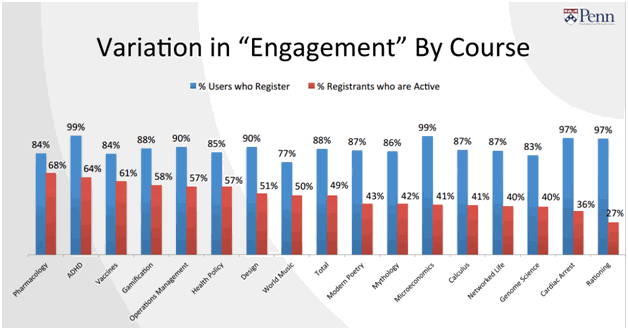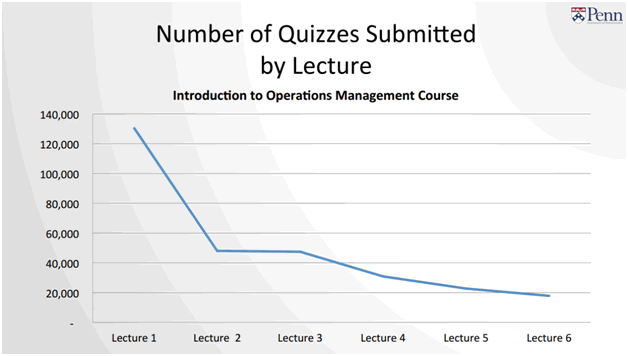MOOCs get a failing grade
Massive Open Online Courses – MOOCs – have no enrollment requirements and as a rule, demand little of the student. Early hopes were that these open access courses would make education work for everyone, but the promise isn’t being fulfilled – perhaps because student expectations aren’t being fulfilled. A University of Pennsylvania study showed completion rates averaged only 4%, rising to a dismal 14% for courses that had fewer demands.
Engagement varied widely by subject, as this chart shows:
And you have to love this chart from the study: it’s practically a representation of human nature. We all start with good intentions, but without more external pressure (like someone taking attendance), we end up like this:
So if MOOCs aren’t the answer, what’s to be done?
Changing Online Courses: Yale Summer Session evolves the SPOC model
Enter the next generation of online teaching: SPOCs. Small Private Online Classes tested with EdX at San Jose University seem to be performing better than MOOCs, and students actually outperformed those in the traditional course.
Meanwhile, quietly and quite successfully, Yale Summer Session has been a forerunner of the SPOC model, with a synchronous, for-credit “online seminar” effort, starting in 2011 with three courses and this year offering 16. Offered only in the summer, the for-credit courses have limited enrollment, a set classtime, and a ‘virtual classroom’ set up that connects the professor by webcam to all participants in a scheduled live webinar/discussion group. Dean William Whobrey, who oversees the courses as part of the Yale Summer Session, noted “We’ve developed an online seminar format that delivers the closest possible experience to actually being in the room.” Part of the appeal for Yale and non-Yale students alike, is the access to ‘star’ professors with international reputations. Students described the experience as ‘intense’ and ‘harder than a regular course.’ Possibly in part because there’s no hiding when you’re all on screen.
The ‘flipped” classroom model: when Khan can’t
In the K-12 realm, digital integration revolves around the Khan Academy ‘flipped’ classroom model – where students do the coursework at home and spend class time getting individual help — but it is struggling to gain traction in the real world.
In Maryland, Queen Anne’s County Commissioner Bob Simmons spent years trying to work with the teachers and administration to get a trial, but he noted, “It’s hard to move people away from the familiar, even when there’s something better.”
The Catch-22 seems to be about proving the concept. Flipping is a major change for teachers, more accustomed to being “the sage on the stage.” Testing and iteration is a central idea in the digital development world, where change is constant. But in the real world, politicians need CYA insurance. Notes Simmons, “Until the state school board allows flexibility and freedom to make trials at the local level, progress in changes in teaching methods are going to be extremely slow.” His frustration is palpable: “The state answer was that when we had presented a system that had the support of the taxpayers, the parents, and the teachers, they would consider giving us help. How can we propose a system to our citizens when we have no help from the state about what changes may be made or not made?”
As he sees it, “the probability is that the full potential of “flipping the classroom” is more likely to be realized in private schools, or schools less politically controlled.”
Other challenges for online education
Or maybe at least funded by private money. In Boise, Idaho, a 48 school pilot project in classroom flipping was privately funded and given a year trial. But the next year, the state rejected a motion to give every student a laptop.
Which brings me to my final point. There’s still an inherent inequity in any of these systems. And the name of the inequity is access. The UPenn assessment noted that enrollees in the “sixteen Coursera courses offered by the University of Pennsylvania from June 2012 to June 2013” were “disproportionately educated, male, and wealthy.” Source: http://www.gse.upenn.edu/pdf/ahead/perna_ruby_boruch_moocs_dec2013.pdf
And an excellent blog on Mind/Shift points out that less educated students had more difficulty with the technical demands of the (online) course. Lack of access to computers and internet service is a reality for many Americans – primarily those with less education and lower income. A Pew Study showed this digital divide is significant: “Almost 90 percent of college graduates have high-speed Internet access at home, as do households earning more than $75,000. Compare that to only 37 percent of those who have not completed high school — as well as 54 percent of households with income less than $30,000 — that have such access.“ Where do those without household internet access turn? To the library. According to the American Library Association, “56% of internet users without home access said public libraries’ basic technological resources (such as computers, internet, and printers) were “very important” to them and their family.” Meanwhile the economic pressures that drive libraries to shorten their hours add time and organizational pressure to an already stressed student population. Common sense says we can’t increase the importance of internet teaching – MOOC, SPOC, or KHAN — unless the students we’re trying to reach have reasonable access to the internet.


